Passive Flow Control Application Using Single and Double Vortex Generator on S809 Wind Turbine Airfoil
Abstract
1. Introduction
2. Investigation Methods
2.1. Experimental Arrangements
2.1.1. Test Model and Wind Tunnel
2.1.2. The Smoke-Wire Test
2.1.3. Hotwire Experiment
2.2. Numerical Method
3. Results and Discussion
4. Conclusions
Author Contributions
Funding
Data Availability Statement
Acknowledgments
Conflicts of Interest
References
- Ung, S.K.; Chong, W.T.; Mat, S.; Ng, J.H.; Kok, Y.H.; Wong, K.H. Investigation into the aerodynamic performance of a vertical axis wind turbine with endplate design. Energies 2022, 15, 6925. [Google Scholar] [CrossRef]
- Çiftci, C.; Erdoğan, A.; Genç, M.S. Investigation of the Mechanical Behavior of a New Generation Wind Turbine Blade Technology. Energies 2023, 16, 1961. [Google Scholar] [CrossRef]
- Özden, M.; Genç, M.S.; Koca, K. Investigation of the effect of hidden vortex generator-flap integrated mechanism revealed in low velocities on wind turbine blade flow. Energy Convers. Manag. 2023, 287, 117107. [Google Scholar] [CrossRef]
- Das, T.K.; Samad, A. Influence of stall fences on the performance of Wells turbine. Energy 2020, 194, 116864. [Google Scholar] [CrossRef]
- Gerrie, C.; Islam, S.Z.; Gerrie, S.; Turner, N.; Asim, T. 3D CFD Modelling of Performance of a Vertical Axis Turbine. Energies 2023, 16, 1144. [Google Scholar] [CrossRef]
- Anup, K.C.; Whale, J.; Urmee, T. Urban wind conditions and small wind turbines in the built environment: A review. Renew. Energy 2019, 131, 268–283. [Google Scholar]
- Açıkel, H.H.; Genç, M.S. Flow control with perpendicular acoustic forcing on NACA 2415 aerofoil at low Reynolds numbers. Proc. Inst. Mech. Eng. Part G J. Aerosp. Eng. 2016, 230, 2447–2462. [Google Scholar] [CrossRef]
- Zhong, J.; Li, J.; Liu, H. Dynamic mode decomposition analysis of flow separation control on wind turbine airfoil using leading-edge rod. Energy 2023, 268, 126656. [Google Scholar] [CrossRef]
- Karasu, İ.; Genç, M.S.; Açıkel, H.; Akpolat, M.T. An experimental study on laminar separation bubble and transition over an aerofoil at low Reynolds number. In Proceedings of the 30th AIAA Applied Aerodynamics Conference, AIAA-3030, New Orleans, LA, USA, 25–28 June 2012. [Google Scholar]
- Genç, M.S.; Lock, G.; Kaynak, Ü. An experimental and computational study of low Re number transitional flows over an aerofoil with leading edge slat. In Proceedings of the 26th Congress of ICAS and 8th AIAA ATIO, AIAA-8877, Anchorage, AK, USA, 14–19 September 2008. [Google Scholar]
- Koca, K.; Genç, M.S.; Açıkel, H.H.; Çağdaş, M.; Bodur, T.M. Identification of flow phenomena over NACA 4412 wind turbine airfoil at low Reynolds numbers and role of laminar separation bubble on flow evolution. Energy 2018, 144, 750–764. [Google Scholar] [CrossRef]
- Koca, K.; Genç, M.S.; Özkan, R. Mapping of laminar separation bubble and bubble-induced vibrations over a turbine blade at low Reynolds numbers. Ocean. Eng. 2021, 239, 109867. [Google Scholar] [CrossRef]
- Koca, K.; Genç, M.S.; Veerasamy, D.; Özden, M. Experimental flow control investigation over suction surface of turbine blade with local surface passive oscillation. Ocean. Eng. 2022, 266, 113024. [Google Scholar] [CrossRef]
- Das, T.K.; Islam, N.; Samad, A.; Pasha, A.A. Passive flow control via tip grooving and stall fencing mechanisms of a marine energy harvesting turbine. Sci. Rep. 2023, 13, 2677. [Google Scholar] [CrossRef] [PubMed]
- Karasu, İ. Flow control over a diamond-shaped cylinder using slits. Exp. Therm. Fluid Sci. 2020, 112, 109992. [Google Scholar] [CrossRef]
- Qian, Y.; Zhang, Y.; Sun, Y.; Wang, T. Numerical investigations of the flow control effect on a thick wind turbine airfoil using deformable trailing edge flaps. Energy 2023, 265, 126327. [Google Scholar] [CrossRef]
- Genç, M.S.; Kaynak, Ü. Control of flow separation and transition point over an aerofoil at low Re number using simultaneous blowing and suction. In Proceedings of the 19th AIAA Computational Fluid Dynamics, AIAA-3672, San Antonio, TX, USA, 22–25 June 2009. [Google Scholar]
- Koca, K.; Genç, M.S.; Bayır, E.; Soğuksu, F.K. Experimental study of the wind turbine airfoil with the local flexibility at different locations for more energy output. Energy 2022, 239, 121887. [Google Scholar] [CrossRef]
- Dong, H.; Xia, T.; Chen, L.; Liu, S.; Cui, Y.D.; Khoo, B.C.; Zhao, A. Study on flow separation and transition of the airfoil in low Reynolds number. Phys. Fluids 2019, 31, 103601. [Google Scholar]
- Tumse, S.; Karasu, I.; Sahin, B. Experimental investigation of ground effect on the vortical flow structure of a 40° swept Delta Wing. J. Aerosp. Eng. 2022, 35, 04022055. [Google Scholar] [CrossRef]
- Özden, K.S.; Karasu, İ.; Genç, M.S. Experimental investigation of the ground effect on a wing without/with trailing edge flap. Fluid Dyn. Res. 2020, 52, 045504. [Google Scholar] [CrossRef]
- Demir, H.; Genç, M.S. An experimental investigation of laminar separation bubble formation on flexible membrane wing. Eur. J. Mech. B/Fluids 2017, 65, 326–338. [Google Scholar] [CrossRef]
- Genç, M.S.; Demir, H.; Özden, M.; Bodur, T.M. Experimental analysis of fluid-structure interaction in flexible wings at low Reynolds number flows. Aircr. Eng. Aerosp. Technol. 2021, 93, 1060–1075. [Google Scholar] [CrossRef]
- Genç, M.S.; Koca, K.; Açıkel, H.H. Investigation of pre-stall flow control on wind turbine blade airfoil using roughness element. Energy 2019, 176, 320–334. [Google Scholar] [CrossRef]
- Genç, M.S.; Koca, K.; Demir, H.; Açıkel, H.H. Traditional and New Types of Passive Flow Control Techniques to Pave the Way for High Maneuverability and Low Structural Weight for UAVs and MAVs. In Autonomous Vehicles; IntechOpen: London, UK, 2020. [Google Scholar]
- Arcondoulis, E.J.G.; Doolan, C.J.; Zander, A.C.; Brooks, L.A. A Review of Trailing Edge Noise Generated by Airfoils at Low to Moderate Reynolds Number. Acoust. Aust. 2010, 38, 129–133. [Google Scholar]
- Sheikhnejad, Y.; Nassab, S.A.G. Enhancement of Solar Chimney Performance by passive vortex generator. Renew. Energy 2021, 169, 437–450. [Google Scholar] [CrossRef]
- Zhu, C.; Wang, T.; Wu, J. Numerical investigation of passive vortex generators on a wind turbine airfoil undergoing pitch oscillations. Energies 2019, 12, 654. [Google Scholar] [CrossRef]
- Meana-Fernández, A.; Fernández Oro, J.M.; Argüelles Díaz, K.M.; Velarde-Suárez, S. Turbulence-model comparison for aerodynamic-performance prediction of a typical vertical-axis wind-turbine airfoil. Energies 2019, 12, 488. [Google Scholar] [CrossRef]
- Ye, X.; Hu, J.; Zheng, N.; Li, C. Numerical study on aerodynamic performance and noise of wind turbine airfoils with serrated gurney flap. Energy 2023, 262, 125574. [Google Scholar] [CrossRef]
- Taylor, H.D. The Elimination of Diffuser Separation by Vortex Generators; Technical Report No. R-4012-3; United Aircraft Corporation: Moscow, Russia, 1947. [Google Scholar]
- Gao, L.; Liu, Y.; Han, S.; Yan, J. Aerodynamic performance of a blunt trailing-edge airfoil affected by vortex generators and a trailing-edge wedge. In Proceedings of the 3rd Renewable Power Generation Conference (RPG 2014), Naples, Italy, 24–25 September 2014; pp. 1–6. [Google Scholar]
- Gao, L.; Zhang, H.; Liu, Y.; Han, S. Effects of vortex generators on a blunt trailing-edge airfoil for wind turbines. Renew. Energy 2015, 76, 303–311. [Google Scholar] [CrossRef]
- Prince, S.A.; Badalamenti, C.; Regas, C. The application of passive air jet vortex-generators to stall suppression on wind turbine blades. Wind. Energy 2017, 20, 109–123. [Google Scholar] [CrossRef]
- Seshagiri, A.; Cooper, E.; Traub, L.W. Effects of vortex generators on an airfoil at low Reynolds numbers. J. Aircr. 2009, 46, 116–122. [Google Scholar] [CrossRef]
- Baldacchino, D.; Ferreira, C.; Tavernier, D.D.; Timmer, W.A.; Van Bussel, G.J.W. Experimental parameter study for passive vortex generators on a 30% thick airfoil. Wind. Energy 2018, 21, 745–765. [Google Scholar] [CrossRef]
- Sutardi, S.; Nurcahya, A.E. Experimental study on the effect of vortex generator on the aerodynamic characteristics of Nasa ls-0417 airfoil. Appl. Mech. Mater. 2015, 758, 63–69. [Google Scholar] [CrossRef]
- Godard, G.; Stanislas, M. Control of a decelerating boundary layer. Part 1: Optimization of passive vortex generators. Aerosp. Sci. Technol. 2006, 10, 181–191. [Google Scholar] [CrossRef]
- Wang, H.; Zhang, B.; Qiu, Q.; Xu, X. Flow control on the NREL S809 wind turbine airfoil using vortex generators. Energy 2017, 118, 1210–1221. [Google Scholar] [CrossRef]
- Zhao, Z.; Zeng, G.; Wang, T.; Xu, B.; Zheng, Y. Numerical research on effect of transition on aerodynamic performance of wind turbine blade with vortex generators. J. Renew. Sustain. Energy 2016, 8, 063308. [Google Scholar] [CrossRef]
- Tian, Q.Q.; Corson, D.; Baker, J.P. Application of vortex generators to wind turbine blades. In Proceedings of the 34th Wind Energy Symposium, San Diego, CA, USA, 4–8 January 2016; p. 518. [Google Scholar]
- Manolesos, M.; Voutsinas, S.G. Experimental investigation of the flow past passive vortex generators on an airfoil experiencing three-dimensional separation. J. Wind. Eng. Ind. Aerodyn. 2015, 142, 130–148. [Google Scholar] [CrossRef]
- Forster, K.J.; White, T.R. Numerical investigation into vortex generators on heavily cambered wings. AIAA J. 2014, 52, 1059–1071. [Google Scholar] [CrossRef]
- Fouatih, O.M.; Medale, M.; Imine, O.; Imine, B. Design optimization of the aerodynamic passive flow control on NACA 4415 airfoil using vortex generators. Eur. J. Mech. -B/Fluids 2016, 56, 82–96. [Google Scholar] [CrossRef]
- Zhu, C.; Feng, Y.; Shen, X.; Dang, Z.; Chen, J.; Qiu, Y.; Feng, Y.; Wang, T. Effects of the height and chordwise installation of the vane-type vortex generators on the unsteady aerodynamics of a wind turbine airfoil undergoing dynamic stall. Energy. 2023, 266, 126418. [Google Scholar] [CrossRef]
- Zhu, C.; Qiu, Y.; Feng, Y.; Wang, T.; Li, H. Combined effect of passive vortex generators and leading-edge roughness on dynamic stall of the wind turbine airfoil. Energy Conv Manag. 2022, 251, 115015. [Google Scholar] [CrossRef]
- Genç, M.S.; Koca, K.; Açıkel, H.H.; Özkan, G.; Kırış, M.S.; Yıldız, R. Flow characteristics over NACA4412 airfoil at low Reynolds number. In EPJ Web Of Conferences; EDP Sciences: Les Ulis, France, 2016; Volume 114. [Google Scholar]
- Koca, K.; Genç, M.S.; Ertürk, S. Impact of local flexible membrane on power efficiency stability at wind turbine blade. Renew. Energy 2022, 197, 1163–1173. [Google Scholar] [CrossRef]
- Wang, P.; Liu, Q.; Li, C.; Miao, W.; Yue, M.; Xu, Z. Investigation of the aerodynamic characteristics of horizontal axis wind turbine using an active flow control method via boundary layer suction. Renew. Energy 2022, 198, 1032–1048. [Google Scholar] [CrossRef]
- Zhu, C.; Chen, J.; Wu, J.; Wang, T. Dynamic stall control of the wind turbine airfoil via single-row and double-row passive vortex generators. Energy. 2019, 189, 116272. [Google Scholar] [CrossRef]
- Chen, T.Y.; Liou, L.R. Blockage corrections in wind tunnel tests of small horizontal-axis wind turbines. Exp. Therm. Fluid Sci. 2011, 35, 565–569. [Google Scholar] [CrossRef]
- Karasu, İ.; Özden, M.; Genç, M.S. Performance assessment of transition models for three-dimensional flow over NACA4412 wings at low Reynolds numbers. J. Fluids Eng. 2018, 140, 121102. [Google Scholar] [CrossRef]
- Qu, H.; Hu, J.; Gao, X. The impact of Reynolds number on two-dimensional aerodynamic airfoil flow. In Proceedings of the 2009 World Non-Grid-Connected Wind Power and Energy Conference, Nanjing, China, 24–26 September 2009; pp. 1–4. [Google Scholar]
- Ducoin, A.; Loiseau, J.C.; Robinet, J.C. Numerical investigation of the interaction between laminar to turbulent transition and the wake of an airfoil. Eur. J. Mech. -B/Fluids 2016, 57, 231–248. [Google Scholar] [CrossRef]

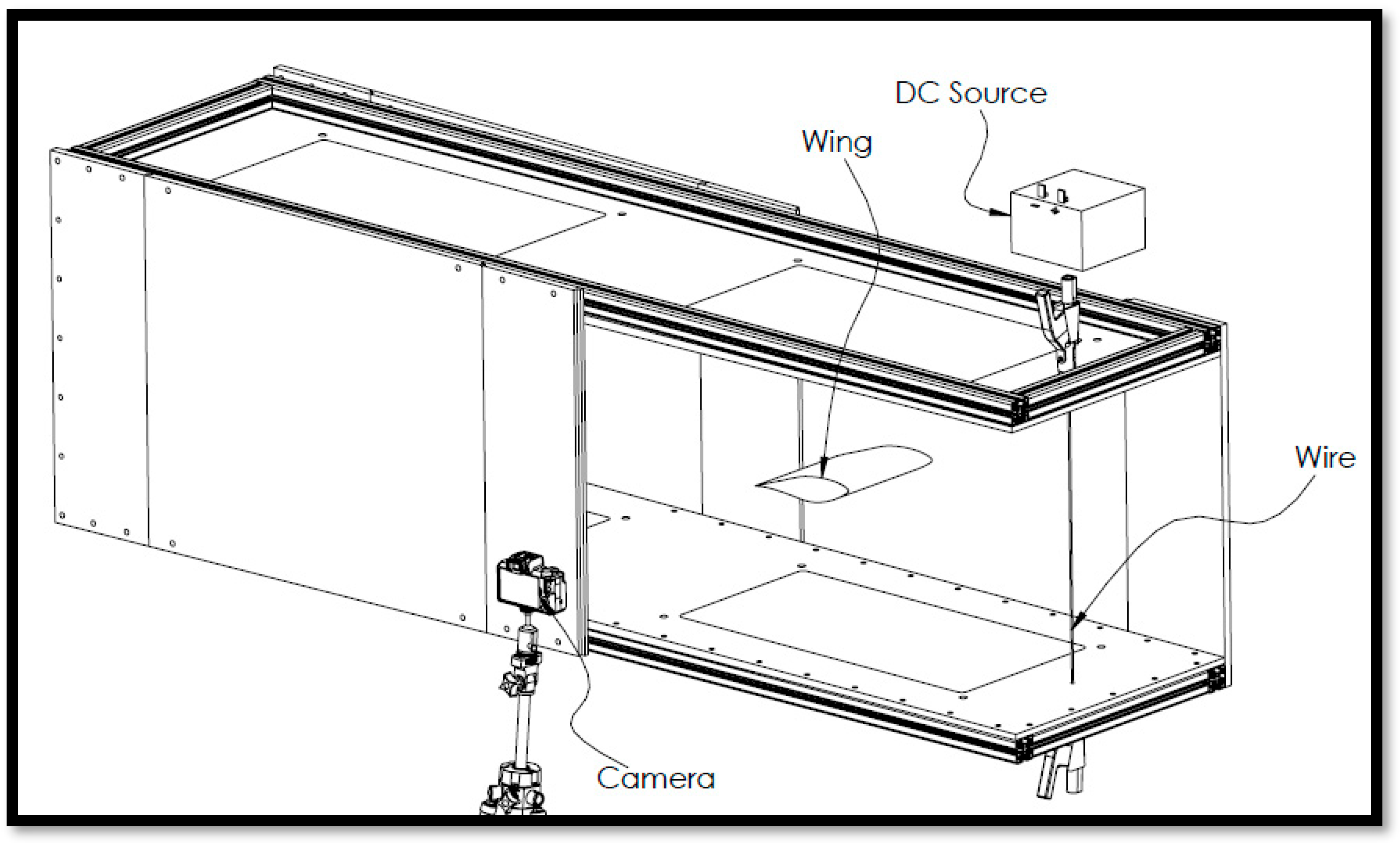
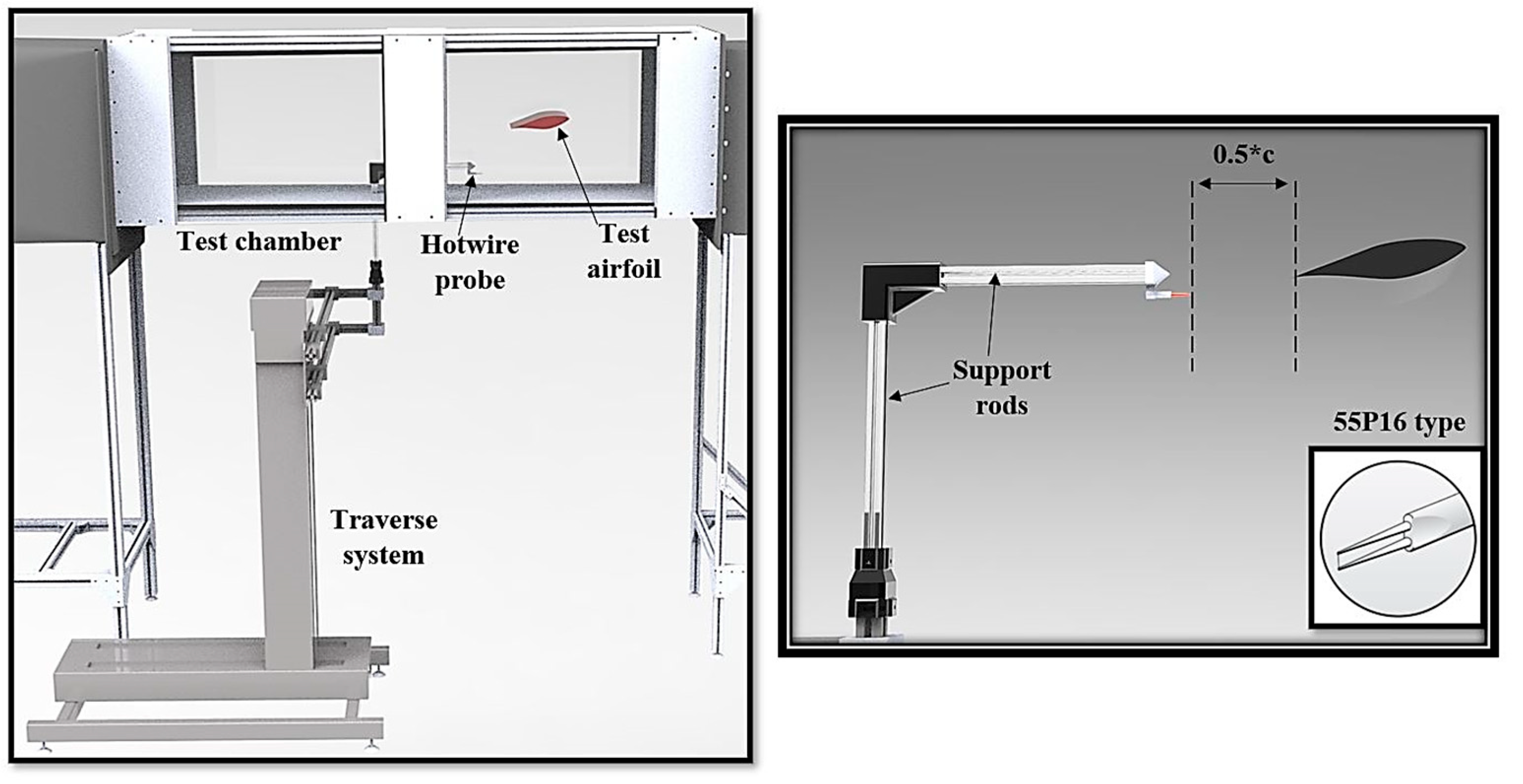
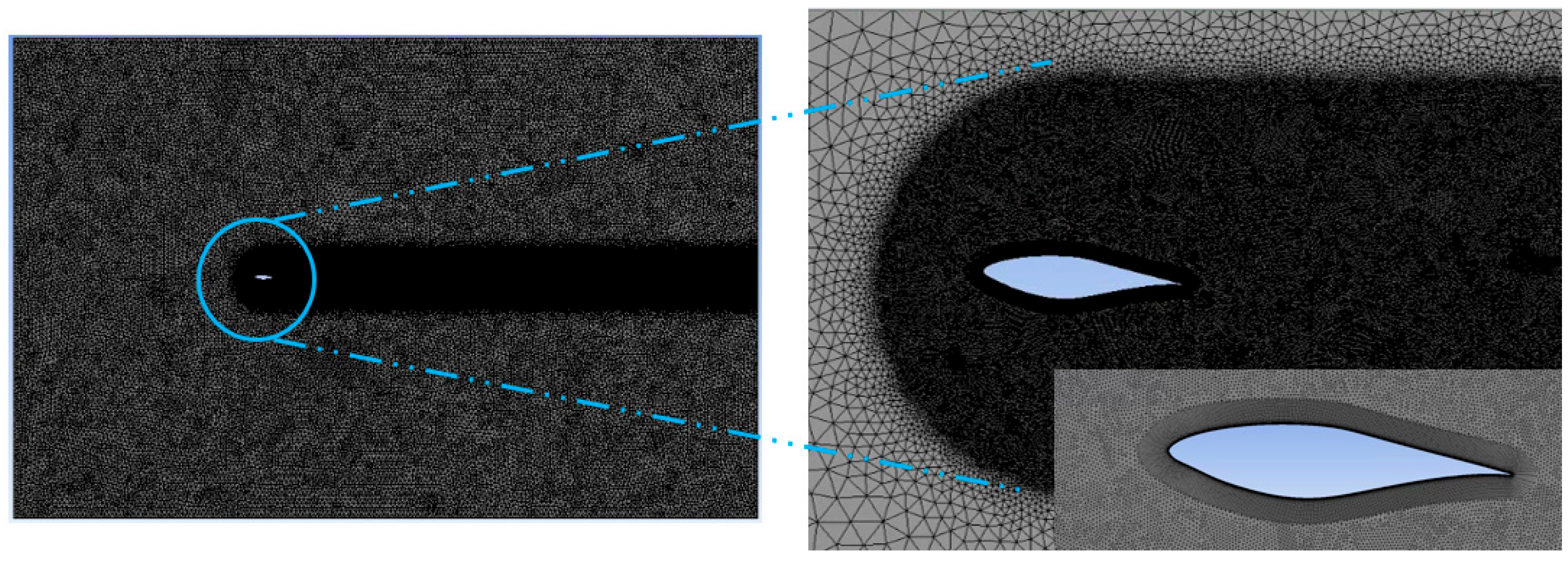


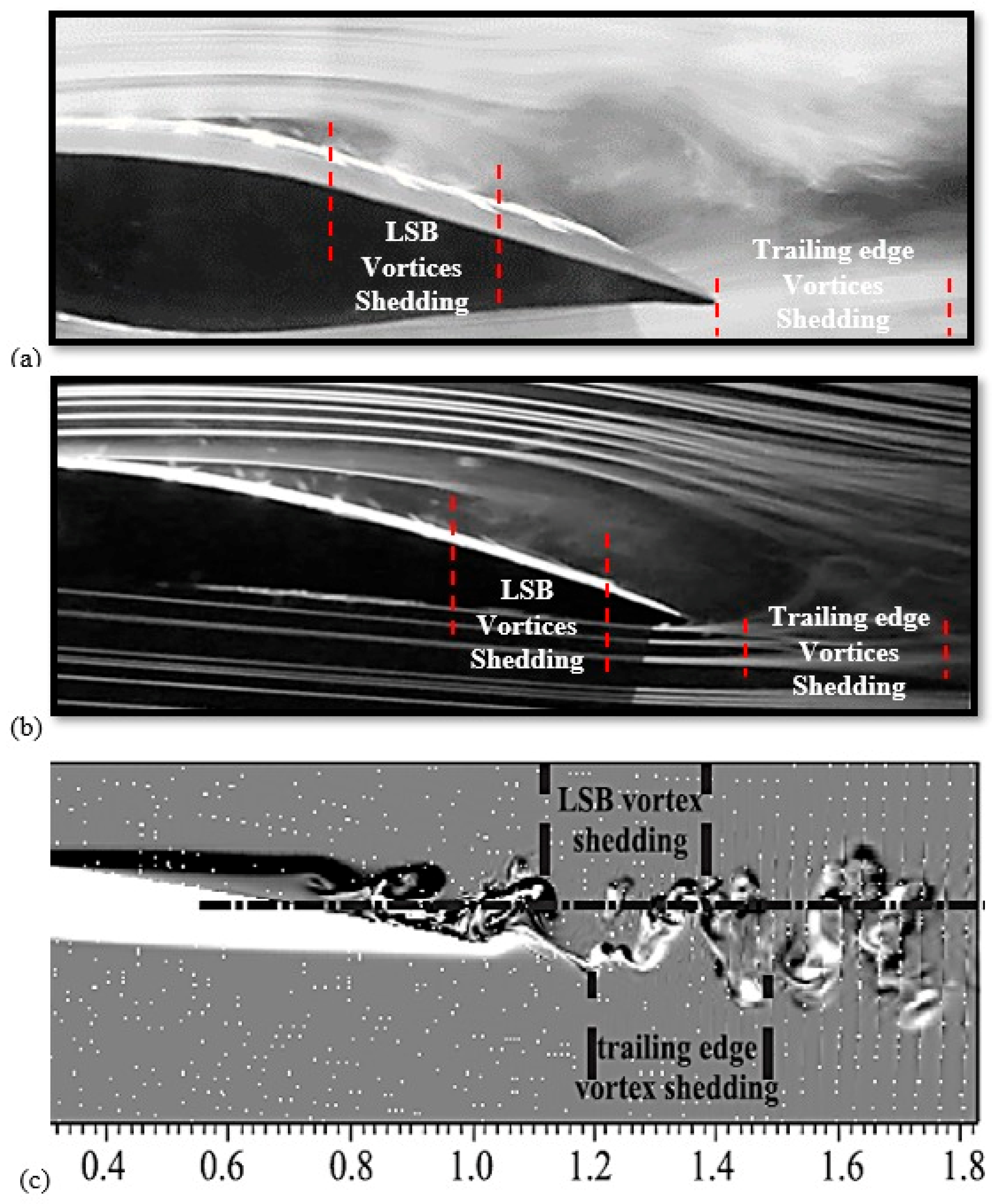

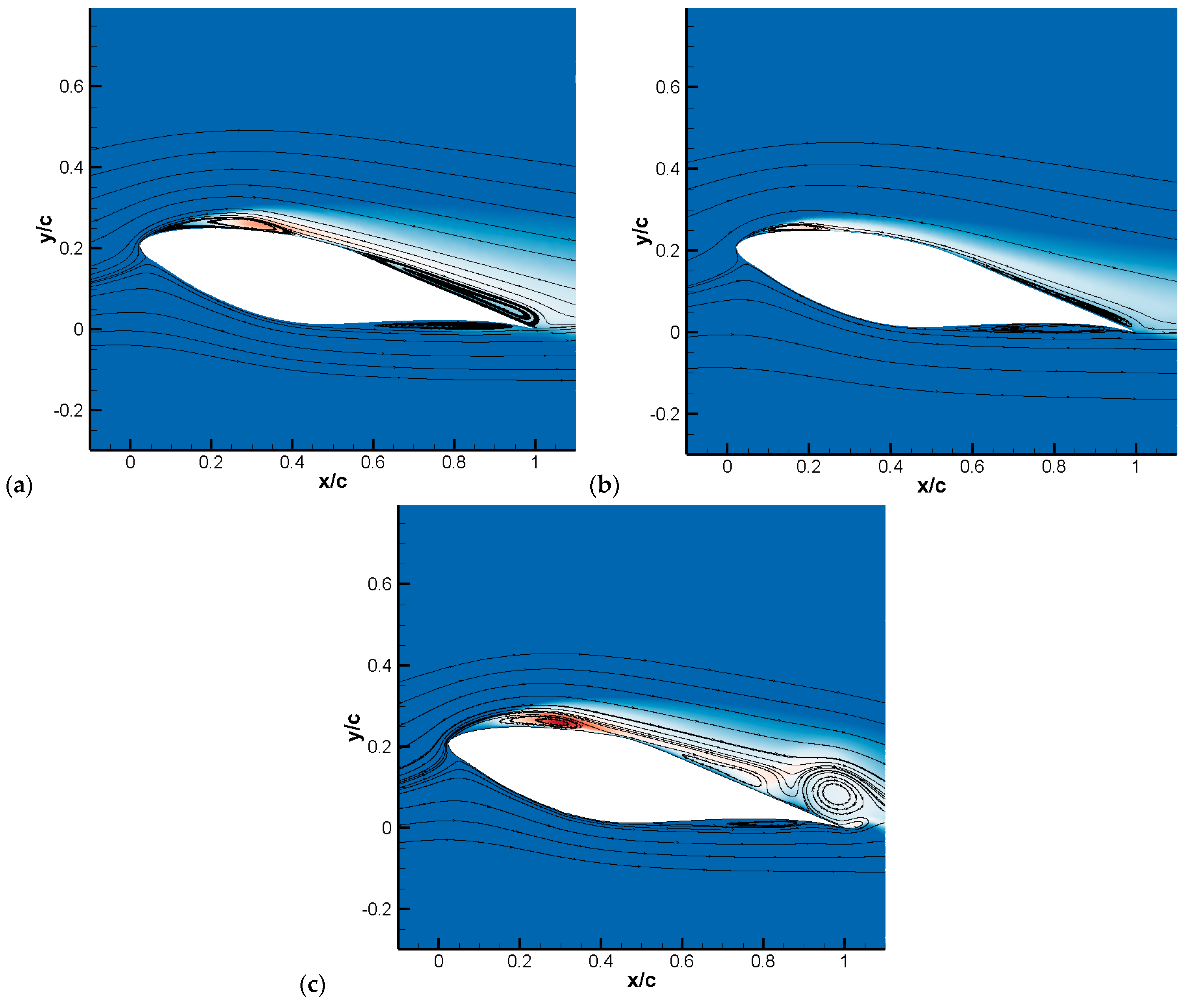
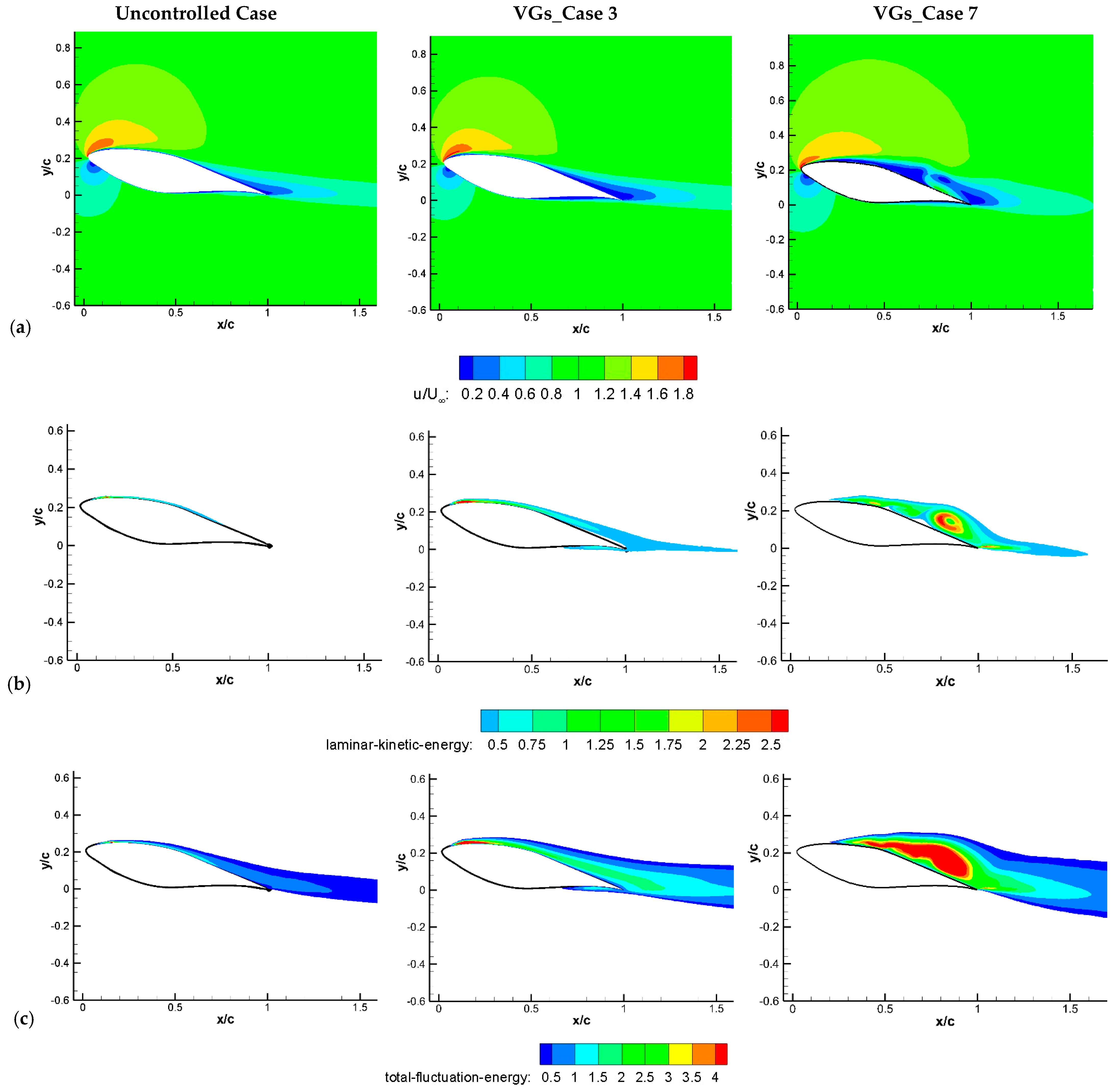
| Test Specimen | Reynolds Number Range or Free-Stream Velocity | Study Type | Explanation | Citation |
|---|---|---|---|---|
| DU-97-W-300 | 3 × 106 | CFD simulation | Using VGs resulted in both an increment in the maximum lift and increase in the stall angle. | [32,33] |
| NACA 23012C NACA 632217 | 0.7 × 106 < Rec < 1.1 × 106 0.27 × 106 < Rec < 1.3 × 106 | Wind tunnel research | For both airfoils, an increase in CL, max and delay in drag rise was observed. Furthermore, suppression of trailing-edge flow separation was observed. | [34] |
| LS(1)-0417GA(W)-1 | 0.8 × 105 and 1.6 × 105 | Wind tunnel research | At higher Reynolds number, a rise in both the stall angle and maximum lift coefficient was observed. | [35] |
| DU-97-W-300 | 2 × 106 | Wind tunnel research | Using VGs helped the stall to decrease. Furthermore, the load fluctuations were increased in the stall regime employing VGs. | [36] |
| NASA LS-0417 | 0.83 × 105 and 1.18 × 105 | Wind tunnel research | The improvement in airfoil performance did not occur when implementing NASA LS-0417 at given Reynolds numbers. But at a larger Reynolds number, CL/CD increased by approximately 36%. | [37] |
| Simpler (2D) geometry | Between 1 m/s and 10 m/s | Wind tunnel research | Two different VG applications were investigated. The results show that VGs with counter-rotating types ensured better results compared to VGs with co-rotating configurations. | [38] |
| NREL S809_1 | 1 × 106 | CFD simulation | Their results indicate that the installation of VGs at the 10% chord position caused the stall phenomenon to increase from 14° to 18°. In addition, the output power was extracted around 96.48% when the double VG configuration was utilized. | [39] |
| DU91-W2-250 | 2 × 106 | CFD simulation | The used computational models are compared with the experimental results presented in the literature. They exhibited great coherence between each other. Moreover, the vortex sheds coming from the VGs caused the stream flow to remain attached to the solid surface. | [40] |
| NACA 4415 S814 | 1.5 × 106 | CFD simulation | Their results conclude that the stall was postponed, and the maximum lift increased. | [41] |
| NTUA-T18 | 0.87 × 106 | Wind tunnel research | The stall cell was postponed for α = 5°, and the lift rose to α = 15° | [42] |
| RAF-19 | 1.93 × 105 | CFD simulation | The positive effects of VGs exhibited a more dominant and crucial role in more cambered airfoils than less cambered airfoils. | [43] |
| NACA 4415 | 2 × 105 | Wind tunnel research | In terms of controlling the boundary layer separation, the triangular VG type was best suited. Also, using the coupled VGs ensured the maximum lift coefficient increase by 21%, while the flow separation was postponed by 17°. | [44] |
| NREL S809_2 | 1 × 106 | CFD simulation | The vortex generators located at different x/c on the airfoil suction surface were investigated numerically. In addition to the location, a detailed study was conducted on the height of the vortex generator. | [45,46] |
| Design | Suction Type and Low Speed |
|---|---|
| Length of tunnel | 13 m |
| Test section | Length (4 m), Height (0.5 m), Width (0.5 m) |
| Motor | Type: DC motor; Power: 15 kW; Frequency: 50 Hz |
| Model | H4, 1000/15A |
| Capacity | 45,000 m3/h, 450 PA |
| Flow velocity | 3 m/s < U < 40 m/s |
| Turbulence level | 0.3% < Tu < ~0.9% |
| Nozzle | Contraction cone: 9:1 |
| Configurations | Positions of VGs | Sketches |
|---|---|---|
| Case 1 | Suction surface x/c = 0.1 |  |
| Pressure surface Not applied | ||
| Case 2 | Suction surface x/c = 0.2 | 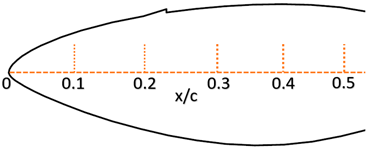 |
| Pressure surface Not applied | ||
| Case 3 | Suction surface x/c = 0.3 |  |
| Pressure surface Not applied | ||
| Case 4 | Suction surface x/c = 0.4 | 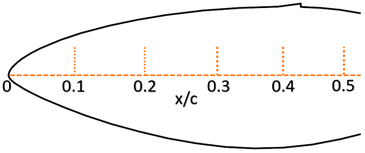 |
| Pressure surface Not applied | ||
| Case 5 | Suction surface x/c = 0.5 | 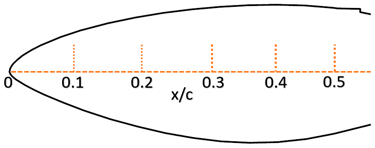 |
| Pressure surface Not applied | ||
| Case 6 | Suction surface x/c = 0.3 | 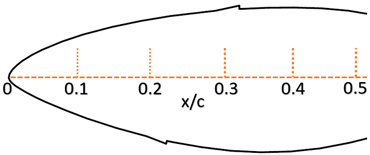 |
| Pressure surface x/c = 0.2 | ||
| Case 7 | Suction surface x/c = 0.3 | 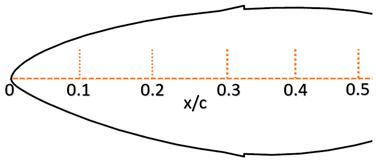 |
| Pressure surface x/c = 0.3 | ||
| Case 8 | Suction surface x/c = 0.3 | 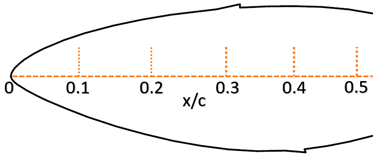 |
| Pressure surface x/c = 0.4 |
| CL at α = 8° | Re = 0.4 × 105 | Re = 0.8 × 105 | Re = 1.2 × 105 |
|---|---|---|---|
| Uncontrolled Experimental [53] | 0.51 | 0.85 | 0.90 |
| Uncontrolled Numerical | 0.55 | 0.82 | 0.90 |
| Case No. | CL | CD | CL/CD |
|---|---|---|---|
| VGs_Case 1 | 0.7203 | 0.1590 | 4.53 |
| VGs_Case 2 | 1.0400 | 0.0787 | 13.21 |
| VGs_Case 3 | 0.9800 | 0.0738 | 13.27 |
| VGs_Case 4 | 0.7230 | 0.1560 | 4.63 |
| VGs_Case 5 | 0.7310 | 0.1540 | 4.75 |
| VGs_Case 6 | 0.9285 | 0.1761 | 5.27 |
| VGs_Case 7 | 1.1688 | 0.1058 | 11.01 |
| VGs_Case 8 | 1.0285 | 0.1489 | 6.90 |
| Uncontrolled | 0.9638 | 0.0868 | 11.10 |
| α = 12° | Uncontrolled | VGs_Case_3 | VGs_Case_7 | |||
|---|---|---|---|---|---|---|
| Reynolds Number | CL | CD | CL | CD | CL | CD |
| Re = 0.4 × 105 | 0.9638 | 0.0868 | 0.9800 | 0.0738 | 1.1688 | 0.1058 |
| Re = 0.6 × 105 | 1.1577 | 0.0781 | 1.0435 | 0.0701 | 1.3835 | 0.1689 |
| Re = 0.8 × 105 | 1.0120 | 0.0752 | 1.0225 | 0.0714 | 1.1450 | 0.0741 |
| Re = 1.2 × 105 | 1.1205 | 0.0685 | 1.1029 | 0.0682 | 1.1964 | 0.0681 |
Disclaimer/Publisher’s Note: The statements, opinions and data contained in all publications are solely those of the individual author(s) and contributor(s) and not of MDPI and/or the editor(s). MDPI and/or the editor(s) disclaim responsibility for any injury to people or property resulting from any ideas, methods, instructions or products referred to in the content. |
© 2023 by the authors. Licensee MDPI, Basel, Switzerland. This article is an open access article distributed under the terms and conditions of the Creative Commons Attribution (CC BY) license (https://creativecommons.org/licenses/by/4.0/).
Share and Cite
Özden, M.; Genç, M.S.; Koca, K. Passive Flow Control Application Using Single and Double Vortex Generator on S809 Wind Turbine Airfoil. Energies 2023, 16, 5339. https://doi.org/10.3390/en16145339
Özden M, Genç MS, Koca K. Passive Flow Control Application Using Single and Double Vortex Generator on S809 Wind Turbine Airfoil. Energies. 2023; 16(14):5339. https://doi.org/10.3390/en16145339
Chicago/Turabian StyleÖzden, Mustafa, Mustafa Serdar Genç, and Kemal Koca. 2023. "Passive Flow Control Application Using Single and Double Vortex Generator on S809 Wind Turbine Airfoil" Energies 16, no. 14: 5339. https://doi.org/10.3390/en16145339
APA StyleÖzden, M., Genç, M. S., & Koca, K. (2023). Passive Flow Control Application Using Single and Double Vortex Generator on S809 Wind Turbine Airfoil. Energies, 16(14), 5339. https://doi.org/10.3390/en16145339






